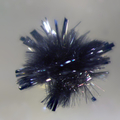Synthesis and identification of metastable compounds:
Black Arsenic: Fact or Fiction?
20.02.2012, News
Phosphorus and arsenic are on top of each other in one group of the periodic table, so they have many similar properties. In addition to tubular forms, phosphorus is found in white, red, black, and purple structural forms. At room temperature, black phosphorus is the stable form; the others are metastable. According to textbooks, arsenic occurs in gray, yellow, and black forms. However, the existence of black arsenic, which should be analogous to black phosphorus, has never been indisputably proven. In the journal Angewandte Chemie, researchers from Technische Universitaet Muenchen, University of Regensburg and Lausitz University of Applied Sciences have now demonstrated that black arsenic is metastable in its pure form, and that it has thus far only been obtained in a form stabilized by atoms of other elements.
In their studies, a team led by Tom Nilges at the Technical University of Munich, Richard Weihrich at the University of Regensburg, and Peer Schmidt at the Lausitz University of Applied Sciences combined quantum chemical computations with experimental investigations of phase formation. The calculations make it possible to estimate the energetic stabilities of various structural forms of pure substances or combinations of solids, which are called solid solutions. Which phases are formed depends not only on this thermodynamic energy content, but also on the speed (kinetics) with which the individual phases form and interconvert. Metastable phases have a higher energy at defined pressures and temperatures than the stable phase. However, because a relatively high energy barrier must initially be overcome in their conversion, they only slowly convert to the stable phase, if at all.
The researchers used gas-phase reactions to study phase formation. In these reactions, the solids are heated and the resulting pressure, which builds through sublimation of particles from the solid, is measured. Particles from a metastable phase enter the gas phase much more easily, so the pressure is higher than for a stable phase. When a metastable phase converts to a stable phase, the drop in pressure can be observed. It is even possible to observe pathways involving multiple different metastable intermediates.
The researchers were thus able to identify all metastable and stable phases of solid solutions of arsenic and phosphorus in all possible ratios. They were thus able to demonstrate that black arsenic is metastable in its pure form.
The results of such experiments do not only provide fundamental academic knowledge, they are also helpful in the development of targeted synthetic pathways for desirable metastable phases. This is of interest for the production of innovative materials, since metastable phases often demonstrate interesting properties. One current example of a metastable phase is an extremely hard diamond that can theoretically spontaneously convert to graphite – at room temperature – but actually never does.
This work was funded by DFG within the SPP 1415 and supported by the TUM Graduate School.
Source: Press release Angewandte Chemie
Original publication:
Synthesis and Identification of Metastable Compounds: Black Arsenic—Science or Fiction?
Oliver Osters, Tom Nilges, Frederik Bachhuber, Florian Pielnhofer, Richard Weihrich, Michael Schöneich und Peer Schmidt
Angewandte Chemie International Edition, Early View Online, 9 Feb 2012 – DOI: 10.1002/anie.201106479
Kontakt:
Prof. Dr. Tom Nilges
Technische Universitaet Muenchen
Synthesis and Characterization of innovative Materials
Lichtenbergstr. 4, 85747 Garching, Germany
Tel. +49 89 289 13110 – Fax +49 89 289 13762
E-Mail – Internet
Kontakt: presse@tum.de




